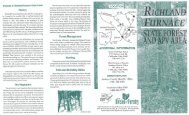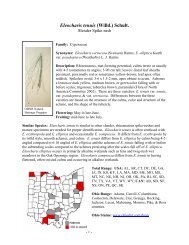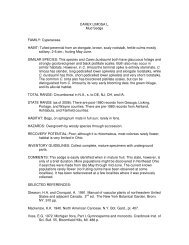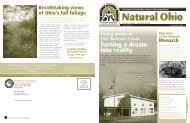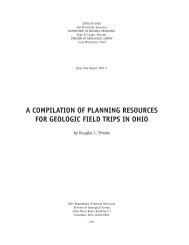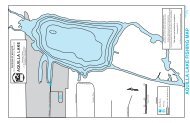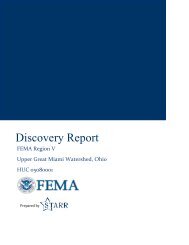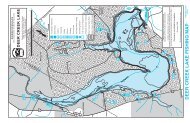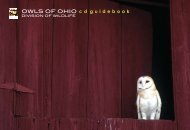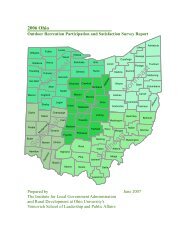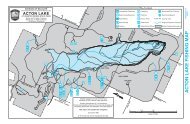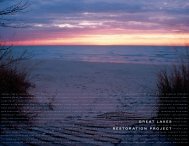special • lake erie • issue - Ohio Department of Natural Resources
special • lake erie • issue - Ohio Department of Natural Resources
special • lake erie • issue - Ohio Department of Natural Resources
Create successful ePaper yourself
Turn your PDF publications into a flip-book with our unique Google optimized e-Paper software.
<strong>Ohio</strong>’s Giant Aviary<br />
continued<br />
managed marshes where water levels are manipulated to create<br />
the abundant food supply <strong>of</strong> aquatic insects.<br />
Raptors<br />
Many raptors are observed in the Lake Erie marsh region<br />
year-round, but large numbers can be seen in the region<br />
during migration periods. Ten thousand to 20,000 raptors can<br />
be observed during the spring migration. Migrating raptors<br />
depend on southwest winds and thermals created along the<br />
coast to make the long flight around the <strong>lake</strong> less energyconsuming.<br />
Raptors <strong>of</strong>ten seen along Lake Erie include bald<br />
eagles, red-tailed hawks, Northern harriers, American kestrels,<br />
osprey, peregrine falcons, and great horned owls.<br />
Songbirds<br />
No birder’s visit to the Lake Erie marsh region is complete<br />
without a stop at Magee Marsh Wildlife Area in Ottawa County,<br />
managed by the Division <strong>of</strong> Wildlife. Birder’s World designates<br />
Magee Marsh as one <strong>of</strong> the top 10 birding locations in the North<br />
America. Magee’s visitors come<br />
for the wading birds, shorebirds,<br />
gulls, terns, waterfowl, raptors,<br />
and songbirds, but it is the 37<br />
species <strong>of</strong> migrating warblers that<br />
attract the most attention during<br />
the spring migration from mid-<br />
April through May.<br />
When a warm front moves<br />
Palm warbler<br />
into <strong>Ohio</strong> with good southwest<br />
winds, migrating songbirds move<br />
through the state and concentrate<br />
on remnant forested beach ridges along the shore. They rest<br />
and refuel here before making their journey around the large<br />
<strong>lake</strong>. Magee’s Boardwalk Bird Trail is situated in one <strong>of</strong> only<br />
four beach ridges along Lake Erie’s southern shore providing<br />
spectacular, up-close observation <strong>of</strong> the warblers. The wildlife<br />
area’s deep and shallow water, open marsh, sedge meadow, and<br />
blue joint grass provide vital habitat with high energy food<br />
supplies for the warblers and other migrating species.<br />
The annual International Migratory Bird Day will be<br />
celebrated at Magee Marsh May 14 with continuous activities<br />
from 8 a.m. to 5 p.m. For<br />
more information on<br />
this and other scheduled<br />
birding activities call the<br />
Sportsman’s Migratory<br />
Bird Center at Magee<br />
Marsh at (419) 898-0960,<br />
ext. 31.<br />
Young egrets in a nest<br />
on West Sister Island,<br />
photographed during<br />
a banding project.<br />
Tim Daniel<br />
Mark Shieldcastle<br />
Tim Daniel<br />
Melissa Hathaway<br />
Red-tailed hawk<br />
Magee Marsh boardwalk<br />
Avian Research<br />
An abundance <strong>of</strong> birds in the Lake Erie marsh region not<br />
only provides a premier birdwatching Mecca, but also a naturally-equipped<br />
laboratory for avian researchers. The Division <strong>of</strong><br />
Wildlife’s avian research is conducted by staff at the Crane Creek<br />
Wildlife Research Station at Magee Marsh in Ottawa County.<br />
The staff, <strong>of</strong>ten in conjunction with other research agencies,<br />
conducts research on wetland bird species at Magee Marsh and<br />
other Division-managed wetlands, as well as West Sister Island.<br />
Managed by the Ottawa National Wildlife Refuge, the 82-acre<br />
West Sister Island in Lake Erie is a designated national wilderness<br />
area and is <strong>of</strong>f limits to the public. Forty percent <strong>of</strong> all nesting<br />
herons and egrets in the Great Lakes region nest on this critical<br />
piece <strong>of</strong> wildlife habitat.<br />
Partnering agencies in avian research include Ducks<br />
Unlimited, Ottawa National Wildlife Refuge, and the Black<br />
Swamp Bird Observatory. Some <strong>of</strong> the current avian research<br />
includes numerous waterfowl surveys, the reintroduction<br />
and management <strong>of</strong> trumpeter swans, and research projects<br />
involving bald eagles, common terns, black-crowned night<br />
herons, great egrets, snowy egrets, double-crested cormorants,<br />
sandhill cranes, and osprey. Division <strong>of</strong> Wildlife staff<br />
also compile the Wetland Breeding Bird Survey with the<br />
help <strong>of</strong> volunteer recorders.<br />
16 WILD OHIO SPRING 2005



